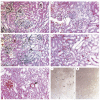C5a is important in the tubulointerstitial component of experimental immune complex glomerulonephritis
- PMID: 12296852
- PMCID: PMC1906496
- DOI: 10.1046/j.1365-2249.2002.01957.x
C5a is important in the tubulointerstitial component of experimental immune complex glomerulonephritis
Abstract
Interstitial injury is the hallmark of glomerulonephritis which is progressing to end-stage renal disease (ESRD). In humans and experimental animals, we have shown that interstitial disease is accompanied by up-regulation of complement components in tubular epithelial cells. Glomerulonephritis was induced in mice by the intraperitoneal injection of horse spleen apoferritin (HSA) and lipopolysaccharide (LPS). In addition to wild-type C57/B6 mice, animals in which the C5a receptor had been deleted (C5aR KO) were used. Animals were killed after 3 or 6 weeks, and kidneys harvested. At three weeks, both groups had evidence of mild mesangial matrix expansion and increased cellularity; there were no crescents, sclerotic lesions, or interstitial disease. At six weeks, glomerular lesions were advanced, but identical in the two groups. Both groups had evidence of an identical pattern of C3 gene expression in the tubular epithelium by in situ hybridization. There was a marked difference, however, in the extent of interstitial injury. Wild-type animals had significantly greater numbers of infiltrating interstitial cells, greater expansion of the peritubular space, more tubular atrophy, and more apoptotic tubular cells than did C5aR KOs. The anaphylotoxic fragment of C5, C5a, is not likely to be important in the glomerular component of this model of progressive glomerulonephritis. On the other hand, the interstitial component is markedly attenuated in knockout animals. These data support a role for complement in the interstitial component of this glomerulonephritis model. They are consistent with our hypotheses of a role for complement in the progression of some forms of glomerulonephritis to ESRD.
Figures


Comment in
-
Leaked protein and interstitial damage in the kidney: is complement the missing link?Clin Exp Immunol. 2002 Oct;130(1):1-3. doi: 10.1046/j.1365-2249.2002.01979.x. Clin Exp Immunol. 2002. PMID: 12296845 Free PMC article. No abstract available.
References
-
- Mackensen-Haen S, Bohle A, Christensen J, Wehrmann M, Kendziorra H, Kokot F. The consequences for renal function of widening of the interstitium and changes in the tubular epithelium of the renal cortex and outer medulla in various renal diseases. Clin Nephrol. 1992;37:70–7. - PubMed
-
- Ong AC, Fine LG. Loss of glomerular function and tubulointerstitial fibrosis: Cause or effect? Kidney Int. 1994;45:345–51. - PubMed
-
- Nath KA, Hostetter MK, Hostetter TH. Ammonia–complement interaction in the pathogenesis of progressive renal injury. Kidney Intsupplement. 1989;27:S52–4. - PubMed
MeSH terms
Substances
LinkOut - more resources
Full Text Sources
Molecular Biology Databases
Research Materials
Miscellaneous

